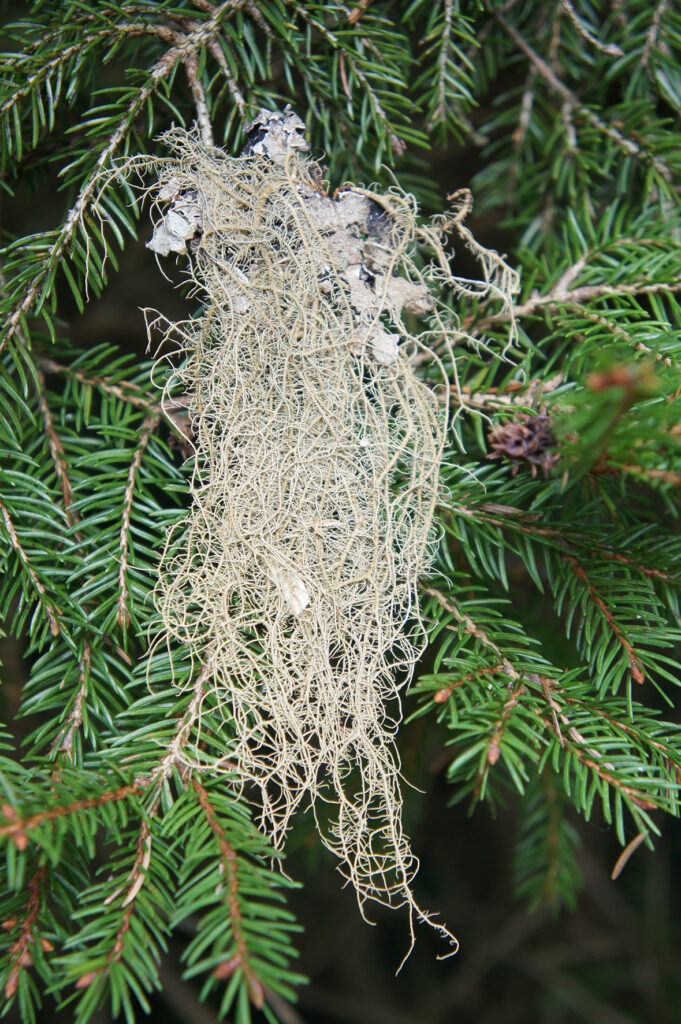Lichens: Teamwork makes the difference
Everywhere, yet superficially inconspicuous – lichens colonize trees or rocks all over the world. However, these creatures perform amazing stuff in secret: Among other things, they produce substances that are of great interest to the pharmaceutical industry. Researchers at the Bavarian State Collection for Botany (SNSB-BSM) and the Technical University of Munich for the first time have been able to demonstrate a metabolic process in intact, living bearded lichens that leads to the production of so-called lichen secondary metabolites. The scientists recently published their results in the scientific journal New Phytologist.
Lichens are symbiotic associations between fungi and photosynthesizing green algae or cyanobacteria. The metabolism of these symbiotic units differs significantly from the metabolism of single symbiotic partners. For example, many lichen secondary metabolites are formed only in symbiosis. The aim of the current study was to analyze the metabolic processes within the lichens – and to do so under conditions as true to life as possible on intact organisms.
Scientists at the Bavarian State Collection for Botany (SNSB-BSM) and the Technical University of Munich (TUM) have now succeeded for the first time in uncovering the complete metabolic process for the production of the lichen compound usnic acid. This was achieved using the so-called 13C-method: the researchers sprayed an isotopically labeled sugar solution ([U-13C]glucose) onto the intact lichen of the species Usnea dasopoga and then analyzed extracts of this lichen using nuclear magnetic resonance spectroscopy (NMR). This analytical method uses a static, homogeneous magnetic field to determine the interaction of atomic nuclei. This principle is also used in nuclear magnetic resonance in medicine. “It has been shown that the 13C method is excellently suited to shed light on the biosynthesis of usnic acid in the complex biological system of a lichen,” says delighted Prof. Wolfgang Eisenreich from TUM.
The lichen under investigation, Usnea dasopoga, is widespread in the Alps and belongs to the group of bearded lichens, which usually grow hanging down from trees. As a special feature of lichens belonging to the genus Usnea, usnic acid is formed, a lichen acid with a complex structure. This compound is very versatile: it has both antiviral and antibacterial effects and it is successfully used in therapies against influenza, hepatitis C and various bacterial-inflammatory diseases. The UV light-absorbing effect of usnic acid is also noteworthy. As it is used in the lifestyle sector as a dietary supplement for weight reduction, possible liver-damaging effects should also be considered as well.
“If we know the pathways and mechanisms of metabolite production inside the lichen, we can understand better the lichen substances and their pharmaceutical potential or further biotechnological use,” explains Dr. Andreas Beck, lichen expert at the Bavarian State Collection for Botany (SNSB-BSM). “In basic research, we now want to use the method to investigate the exchange of substances between the symbiotic partners in even greater detail.”
Publication:
Kuhn, V. , Geisberger, T. , Huber, C. , Beck, A. and Eisenreich, W. (2019), A facile in vivo procedure to analyze metabolic pathways in intact lichens. New Phytol. doi:10.1111/nph.15968
Contact:
Dr. Andreas Beck
SNSB – Botanische Staatssammlung München
Menzinger Str. 67, 80638 München
Tel.: 089 17861 266
E-Mail: beck@snsb.de


